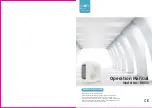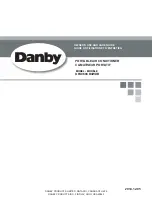
5 Preparation
Installer and user reference guide
10
RXYSQ6T7Y1B9
VRV IV-S system air conditioner
4P404677-1A – 2016.03
In places with weak reception, keep distances of 3 m or more to
avoid electromagnetic disturbance of other equipment and use
conduit tubes for power and transmission lines.
▪ Select a place where rain can be avoided as much as possible.
▪ Take care that in the event of a water leak, water cannot cause
any damage to the installation space and surroundings.
▪ Choose a location where the hot/cold air discharged from the unit
or the operation noise, will NOT disturb anyone.
▪ Heat exchanger fins are sharp and injury is possible. Choose an
installation location where there is no risk for injury (especially in
areas where children play).
Do NOT install the unit in the following places:
▪ Sound sensitive areas (e.g. near a bedroom and the like), so that
the operation noise will cause no trouble.
Note: If the sound is measured under actual installation
conditions, the measured value might be higher than the sound
pressure level mentioned in Sound spectrum in the data book due
to environmental noise and sound reflections.
▪ In places where a mineral oil mist, spray or vapour may be
present in the atmosphere. Plastic parts may deteriorate and fall
off or cause water leakage.
It is NOT recommended to install the unit in the following places
because it may shorten the life of the unit:
▪ Where the voltage fluctuates a lot
▪ In vehicles or vessels
▪ Where acidic or alkaline vapour is present
Seaside installation.
Make sure the outdoor unit is NOT directly
exposed to sea winds. This is to prevent corrosion caused by high
levels of salt in the air, which might shorten the life of the unit.
Install the outdoor unit away from direct sea winds.
Example:
Behind the building.
b
c
a
If the outdoor unit is exposed to direct sea winds, install a
windbreaker.
▪ Height of windbreaker≥1.5×height of outdoor unit
▪ Mind the service space requirements when installing the
windbreaker.
a
b
c
d
c
d
a
Sea wind
b
Building
c
Outdoor unit
d
Windbreaker
Strong winds (≥18 km/h) blowing against the outdoor unit’s air outlet
causes short circuit (suction of discharge air). This may result in:
▪ deterioration of the operational capacity;
▪ frequent frost acceleration in heating operation;
▪ disruption of operation due to decrease of low pressure or
increase of high pressure;
▪ a broken fan (if a strong wind blows continuously on the fan, it
may start rotating very fast, until it breaks).
It is recommended to install a baffle plate when the air outlet is
exposed to wind.
Turn the air outlet side towards the building's wall, fence or screen.
a
a
Make sure there is enough installation space
Set the air outlet side at a right angle to the direction of the wind.
a
a
b
a
Prevailing wind direction
b
Air outlet
5.2.2
Additional installation site requirements
of the outdoor unit in cold climates
Protect the outdoor unit against direct snowfall and take care that the
outdoor unit is NEVER snowed up.
a
b
c
c
d










































